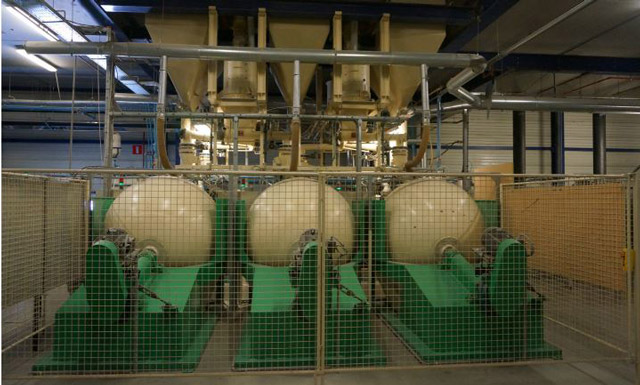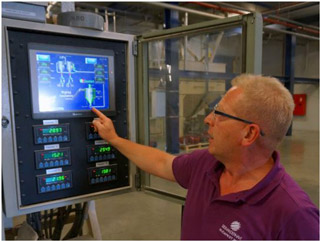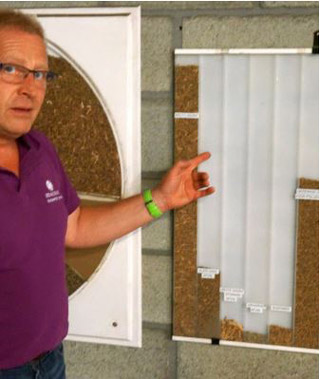Automation expert ensures high-quality production
 SESVanderHave, located in Tienen, Belgium, is
one of the largest beet seed producers in the world. There are many requirements for seed handling that must be met during production, including the application of a special coating made out of an inert wood flour carrier. Thanks to a control system
update, the production process now has better oversight and requires fewer manual corrections.
SESVanderHave, located in Tienen, Belgium, is
one of the largest beet seed producers in the world. There are many requirements for seed handling that must be met during production, including the application of a special coating made out of an inert wood flour carrier. Thanks to a control system
update, the production process now has better oversight and requires fewer manual corrections.
Tienen is Belgium’s leading sugar producer. In addition to sugar beet seed producer SESVanderHave, Tienen is also home to the Tiense Sugar Refinery and Critique Belge, a biotechnology company that develops products using residual ingredients from sugar
beet cultivation and processing. “We originate out of the sugar factory,” describes production manager Benny Jacobs. SESVanderHave holds a 30 to 35 per cent market share, compared to other major sugar beet seed producers. In 2005, the company was
incorporated into France’s Florimond Desprez, a family-owned company founded in 1830. In addition to sugar beet seeds, the agro-industrial group also produces seeds for other plants.
There are 4.2 million hectares of sugar beet crops around the world, and SESVanderHave sells seed for 360 sugar beet breeds in more than 50 countries. The company has additional factories in Kyiv, Ukraine, and Alekseyevka, Russia, along with sales hubs
and local agents in other markets. They have more than 500 employees, half of whom work in Tienen at the head office.
Every year, the factory in Tienen begins the seed process in August, and in March when growing conditions are best, they sow the seeds. Each package contains 100,000 seeds, which can cover approximately one hectare. The Belgian location produces between
800,000 and 900,000 packages annually. To maintain a high-quality seed and accurate harvesting process, each seed must have one germ with sufficient germination and must meet size limits.
Logistics and processing
 Sugar beet cultivation takes two years, so SESVanderHave has to plan two years in advance. Cleaning facilities in southern France and Italy’s northern Po Valley supply the cleanest-possible seeds to the factory in Tienen. “From a quality point of view,
the most important step is to select the right seeds from a bulk supply,” explains Jacobs. The seeds go through another cleaning process and are then sorted by size – between 3.5 and six millimetres – through different sieves. “The remainder is waste,
which goes to the biomass industry,” continues Jacobs.
Sugar beet cultivation takes two years, so SESVanderHave has to plan two years in advance. Cleaning facilities in southern France and Italy’s northern Po Valley supply the cleanest-possible seeds to the factory in Tienen. “From a quality point of view,
the most important step is to select the right seeds from a bulk supply,” explains Jacobs. The seeds go through another cleaning process and are then sorted by size – between 3.5 and six millimetres – through different sieves. “The remainder is waste,
which goes to the biomass industry,” continues Jacobs.
The next step is seed polishing that removes the outer
layer (pericarp). This is done by way of mutual friction forces in a fast rotating drum. Says Jacobs: “This way, the seeds germinate faster after being sowed. Moreover they become a rounder shape, through the so-called ‘pelleting’ process that creates
a nice round pellet.” The seeds are graded by means of a density grader. Underweight seeds – for example, those without a germ – will float, so they are removed. According to Jacobs, the total loss during clean-up is 70 to 75 per cent. The remaining
seed goes into ‘pelleting drums’ which are similar to a concrete mixer. The pelleting drums rotate, so the seeds move three dimensionally. Throughout, humidity and wood flour are dosed and attach to the seeds. The wood flour forms a kind of base layer
for a special coating with active ingredients.
Automation
The Dutch company PENKO Engineering, based in Ede, handled the complete automation of the Tienen factory’s six pelleting drums. The sup�plier is specialised in the develop�ment, production and maintenance of weighing instruments and controllers. Strain
gage load cells were chosen for the pelleting drum positions in the Automation expert ensures high-quality production SESVanderHave updates its beet seed pelleting process Tienen factory, with dosing regulated by specialised controllers. A supervisory
computing system monitors weighing information. Two years ago, the dosing controllers and supervisory system were upgraded because of the economic lifetime. Thanks to a higher measuring and data processing speed, the number of manual corrections is
reduced to a minimum.
The seeds are dosed out of cardboard octabins into the pelleting drums. Production is set up as straight as possible to take advantage of gravity. Each pelleting drum holds a 100-kilo�gram batch. From a screen, the operator can select a formula for the
right size and seed type. “Over a certain amount of time, a selected humidity level and wood flour are dosed,” says Jacobs. “The operator can adjust the process if necessary, since seeds are a natural product whose size can vary. If necessary, smaller
seeds stay in the drum longer. Pelleting requires expertise. The operator has to ensure that there is a sufficient supply of water and wood flour."
Experience
SESVanderHave learned about PENKO from one of their conveying and dosing system suppliers, Dinnissen B.V. “PENKO’s staff proved to be very experienced in the field of dosing system automation, such as those for our pelleting drums,” explains Jacobs.
“One afternoon of consultation was enough to explain the pelleting process and the requirements that we have. Formulas for the correct application of the inert layer around the grain are written based on the knowledge and experience of the operators.”
Coating and packaging
 The process to apply the coating over the layer of wood
flour is fully automatic. Jacobs says that making adjustments during this part of the process isn’t really necessary. The coating contains active components that are necessary to protect the seeds before they go into the ground and after being sown.
“Think of fungicides and insecticides,” Jacobs elaborates. “The blue colour can’t be left out. That colour is our trademark.”
The process to apply the coating over the layer of wood
flour is fully automatic. Jacobs says that making adjustments during this part of the process isn’t really necessary. The coating contains active components that are necessary to protect the seeds before they go into the ground and after being sown.
“Think of fungicides and insecticides,” Jacobs elaborates. “The blue colour can’t be left out. That colour is our trademark.”
After coating and drying, the seeds are put in cardboard boxes weighing approximately 2.8 kilograms and sent to the company’s large warehouse. From there, they’re sent to customers around the world as soon as the sugar beet growing season is started.
Every year, the seeds must be delivered in March.
Pelleting requires expertise
The pelleting drums are mounted on strain gage load cells, with the dosing regulated by specialised controllers.
The state of the art equipment’s faster measuring and data processing speed has greatly reduced the need for manual corrections.
Publication: Solids Processing
Author: Yves De Groote